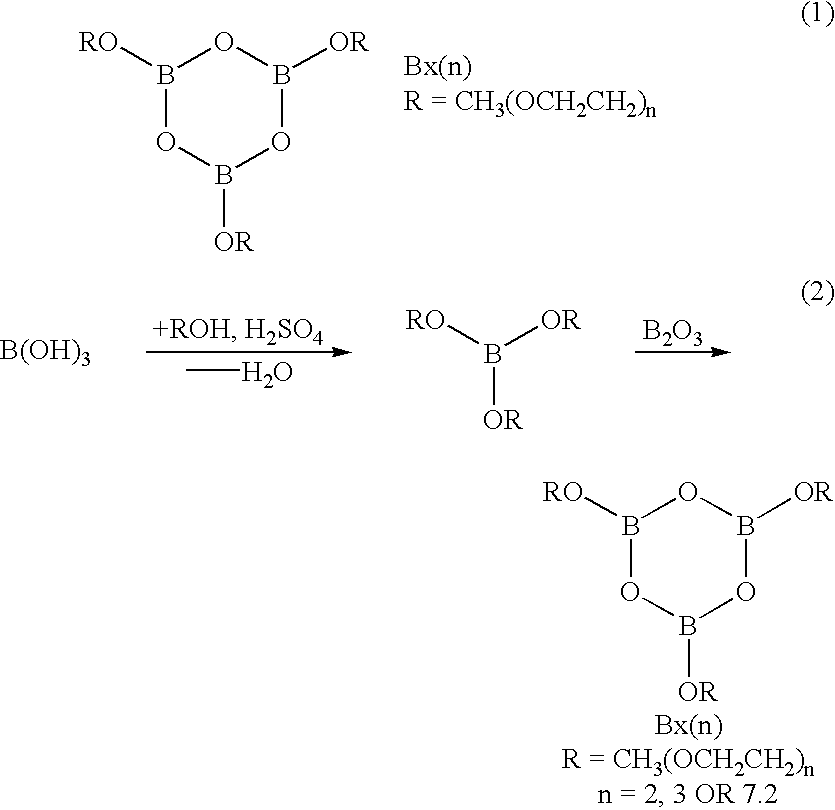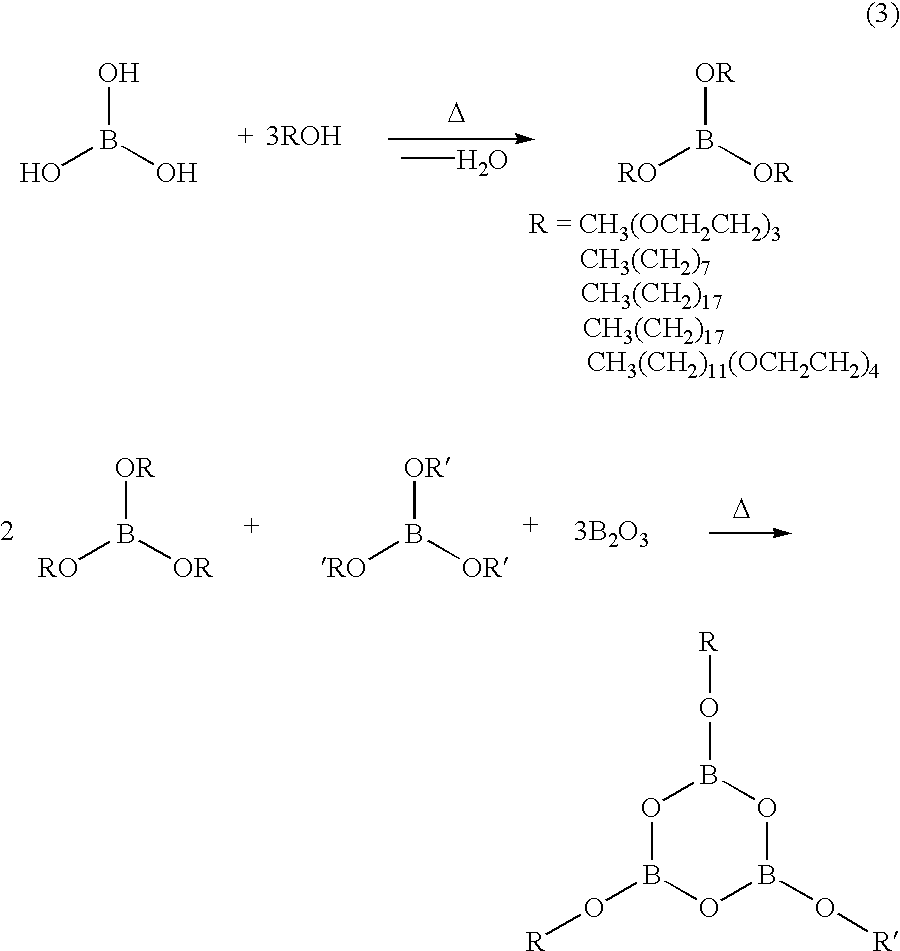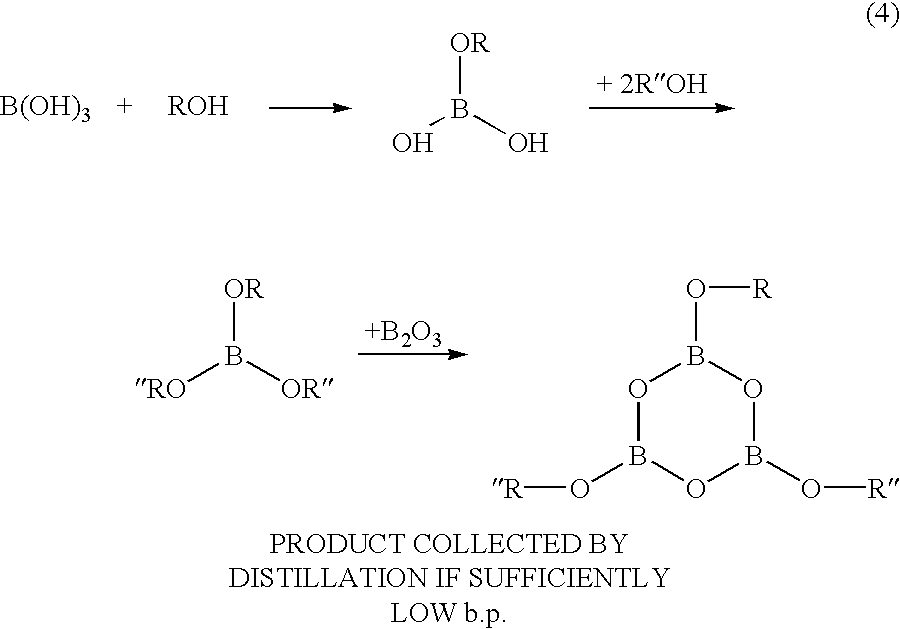Ionically conducting molecule, ionic conductor and process for producing the same
a technology of ionic conductor and ion conducting molecule, which is applied in the direction of group 3/13 element organic compounds, electrochemical generators, non-aqueous electrolyte cells, etc., can solve the problems of reducing the electrochemical stability of trialkoxy boroxine compounds, affecting the movement of the former, and reducing the electrochemical stability of the compound
- Summary
- Abstract
- Description
- Claims
- Application Information
AI Technical Summary
Benefits of technology
Problems solved by technology
Method used
Image
Examples
example no.2
EXAMPLE NO. 2
In Example No. 2, an asymmetric trialkoxy boroxine compound, used as an ionically conducting molecule and containing a variety of different alkoxy groups, could be produced by way of the reaction process illustrated in the following chemical equation (3). ##STR2##
In the production process, boric acid B(OH).sub.3 and an excess of alcohol were heated and refluxed in toluene for 6 hours. The resulting water was removed by azeotropic distillation in a Dean-Stark apparatus. Subsequently, esters of boric acid were obtained by distillation. The esters of boric acid thus obtained were mixed in a molar ratio of 2:1. 3 mols of boric oxide were added to the reaction mixture containing 3 mols of the esters of boric acid (in a ratio of 2:1). The mixture was then heated at 60.degree. C. for 48 hours. Thus, an asymmetric boroxine compound of Example No. 2 having two different alkoxy groups was prepared.
example no.3
EXAMPLE NO. 3
In Example No. 3, an asymmetric trialkoxy boroxine compound, used as an ionically conducting molecule and containing a variety of different alkoxy groups, could be produced by way of the reaction process illustrated in the following chemical equation (4). ##STR3##
In the production process, first, equal molar amounts of boric acid B(OH).sub.3 and an alcohol were heated and refluxed in toluene for 6 hours. The resulting water was removed by azeotropic distillation in a Dean-Stark apparatus. Subsequently, 2 mol equivalents of oligoethylene glycol monomethylether was added to the mixture. The mixture was heated and refluxed in toluene, thereby producing asymmetric esters of boric acid. The asymmetric esters of boric acid exhibiting low boiling points were isolated by distillation. Then, an equal number of mols of boric oxide (B.sub.2 O.sub.3) was added to the asymmetric esters of boric acid. Thereafter, the mixture was heated to 70.degree. C. for 36 hours. Thus, an asymmetr...
example no.4
EXAMPLE NO. 4
In Example No. 4, an ethylene oxide-propylene oxide (EO-PO) copolymer was used as the structural material, the boroxine compound (Bx(n), B.sub.3 O.sub.3 [(OCH.sub.2 CH.sub.2).sub.n OCH.sub.3 ]).sub.3) prepared in Example No. 1 was used as the ionically conducting molecule, and LiCF.sub.3 SO.sub.3 was used as the electrolyte salt for ionic conduction. Namely, in the ionic conductor of Example No. 4, the Bx(n) and LiCF.sub.3 SO.sub.3 were dispersed and immobilized in the EO-PO copolymer.
In the samples of the ionic conductors of Example No. 4, the ratio of EO-PO copolymer and ionically conducting molecule (Bx(n)) as well as the length of the side chains in Bx(n), namely, n in B.sub.3 O.sub.3 [(OCH.sub.2 CH.sub.2).sub.n OCH.sub.3 ]).sub.3 were varied.
As samples of Example No. 4 , ionic conductors having compositions set forth in Table 1 below were prepared, and included EO-PO copolymer, Bx(3), Bx(7.2) and the salt LiCF.sub.3 SO.sub.3. The EO-PO copolymer was composed of EO ...
PUM
| Property | Measurement | Unit |
|---|---|---|
| Temperature | aaaaa | aaaaa |
| Temperature | aaaaa | aaaaa |
| Fraction | aaaaa | aaaaa |
Abstract
Description
Claims
Application Information
 Login to View More
Login to View More - R&D
- Intellectual Property
- Life Sciences
- Materials
- Tech Scout
- Unparalleled Data Quality
- Higher Quality Content
- 60% Fewer Hallucinations
Browse by: Latest US Patents, China's latest patents, Technical Efficacy Thesaurus, Application Domain, Technology Topic, Popular Technical Reports.
© 2025 PatSnap. All rights reserved.Legal|Privacy policy|Modern Slavery Act Transparency Statement|Sitemap|About US| Contact US: help@patsnap.com



